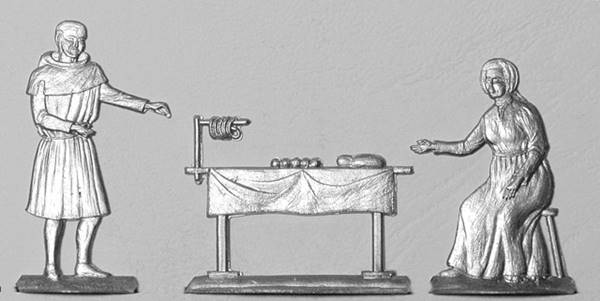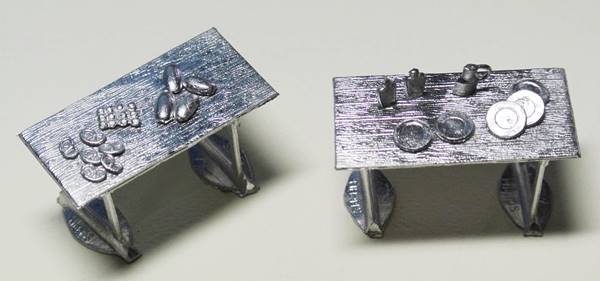Craftsmen and traders II
HH07 The mobile baker
(HH07 - baker's cart, HH07a - baker, HH07b - assistant with basket)

Constance 1414-1418
The baker's cart depicted was created after Ulrich von Richental's chronicle of the Council of Constance.
In an experiment it could be proved that this or similar carts could actually have been in use. The oven, made of fireclay bricks and clay and mounted on a cart, was heated with an open fire. Afterwards, the stored heat enabled a whole range of baked goods, e.g. pies, to be baked and sold directly at the market.
HH08 - The bale binder
(HH08 - Bale binder; HH08a - Journeyman; HH08b - Ropes;
HH08c and d - Bales)

The bale-binder, or the actual packers and loaders, must pack fine and also coarse goods in mats, canvas, wax or packing cloth, in barrels and boxes, in order to protect them from rain and snow, tie them up tightly and lay the goods so that they are stored in the best possible way. The ordinary public bale-binders appointed by the authorities in large towns are obliged to keep an account of the goods packed by them, at which place they worked for which merchant. How many mats, packing canvas, wax or packing cloth, ropes, twine, straw were used and what wages were paid.
HH09 The dyer
(HH09 - dyer, HH09a - assistant , HH09b - dyer's tub; HH09c - women, washing cloth,
HH09d - drying rack, HH09e - sack, HH09f - basket)

The following names can be found, Fläminger (Flemish cloth dyer), Graufärber (grey dyer), Rauschfärber (black dyer), Schönfärber (dyer who uses light colours), Waidfärber (blue dyer).
Washing, mordanting, dyeing (figures HH09 to HH09 b) and rinsing (figure HH09c) were and are the essential operations of the craft.
The work of the dyers was naturally associated with a high environmental impact on nature as well as on the people. High water consumption led to the concentration of workshops along flowing waters. Where this was the case can still be seen today in street names such as Färbergasse or the Färbertor in Nuremberg.
The dyers' task was to give yarns or fabrics a certain, often precisely prescribed colour. Originally, only natural dyes were used, preferably from plants (fruits, seeds, flowers, roots, leaves, wood, bark, herbs), but minerals and animal products were also used.
HH10 The pelvic beater
(HH10 - cymbal beater, HH10a - woman with cymbal, HH10b - table with finished products, HH10c - stool with sheets, HH10d - sheet metal shears, HH10e - wall shelf with cymbals/dishes, HH10f - wall shelf with tools)

Cymbal beaters processed sheet brass. Recurring motifs and embossed shapes suggest some serial production. Diameters of the cymbal beater bowls range between 35 and 60 cm, they have a wide rim ("flag") and were usually decorated with hallmarking and drift work. Older pieces (15th century) are only decorated with a central, radially symmetrical flower motif in free drift work. From about 1500 onwards, individual motifs were driven into the sheet metal with the help of dies. Common motifs include sequences of letters, which often do not make any sense, rosettes of fish bubbles, and depictions of Adam and Eve. Rarer motifs: evangelist symbols, the Lamb of God or the Annunciation.
HH11 Market woman
(HH11 - market woman, HH11a - customer, HH11b - table with baked goods)

HH-MS01 Market stall with baked goods
(Kit consisting of table top, stand and various bakery products) HH-MS02 Market stall with tableware
(kit consisting of table top, stand and various dishes)

The market stalls can be easily assembled, e.g. with 2-component glue, or the tabletop can be used as a shop in a window in the diorama. The small parts are each enclosed twice, so that you can represent a relatively "full" table, but also a less well stocked one.
HH12 - salt hemmer
(HH12a-c = hemmer; HH12d-e = hem horses; HH12f-g = hemmer; HH12h-i = hem horses; HH12j-l = armed escorts; HH12m-o = pinners (loads with barrels or sacks))

With this series, which always includes one of the horses and the 3 load picks twice, pack trains can be depicted in terrain that is impassable for carts. For example, the transport of salt over mule tracks, the Golden Trail in the Bavarian Forest and Bohemian Forest, which connected Bohemia with the Danube at Linz and Passau respectively. The salt was filled into barrels and 2 of these were transported per horse. In addition to the salt, other goods were also transported, which is why a clip-on with the sacks is also available. Other alternative loads will follow, which will then be offered as optional accessories. By means of the attachments, additional horses can be used for the representation, which can add additional variety to the designed scene. In the KLIO magazine No. 12-2006 there is a very comprehensive article on the subject (a figure of a mule driver was presented at that time ...), to which I can add nothing further.
Translated with
www.DeepL.com/Translator (free version)